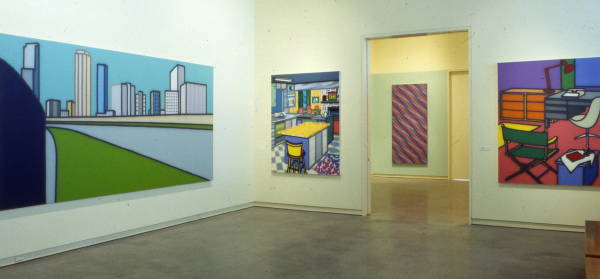‘Downtown: Ruscha, Rooney, Arkley’, Heide, March-May 1995

‘Downtown: Ruscha, Rooney, Arkley’, Museum of Modern Art at Heide, Bulleen (Melbourne), 14 March – 14 May 1995
In this exhibition, Arkley and older Melbourne artist Robert Rooney were matched directly with one of their major international peers, Ed Ruscha (b.1937), long a favourite of Arkley’s.
Juliana Engberg developed a complex curatorial scenario, tracking through both the parallel urban and suburban landscapes of Los Angeles and Melbourne, and the deadpan, consciously repetitive territory of postmodernism.
Monash academic Robert Nelson, writing in the Melbourne Age, found all this a bit much: he described the show as a whole as far too undemonstrative, and argued that Arkley’s image of suburbia was clichéd (a view that annoyed Arkley and infuriated Engberg). Others, though, notably Jeff Gibson, in his review for Art + Text, savoured the dry finish of the show, and Arkley’s contributions to it. [1]
The catalogue included several stimulating accounts of aspects of the urban/suburban theme, among them a witty essay by Virginia Trioli, centring on Arkley’s Our Home (1986), not actually in the show. However, a good selection of his works was included, ranging from serial photos of flywire doors to a recent freeway painting. He also produced a new 10-panel installation for the show, Outside-Inside-Out (1995), designed to read as a stylized suburban room, and reprising the artist’s early ‘door’ format works in a cooler idiom.[2]
Arkleys shown, according to the catalogue, were as listed below (described as in un-named private hands unless noted).
(photo: installation shot, showing, from left, A Freeway Painting (Exit) (1994), Ultrakleen (1992), one of the panels from Outside-Inside-Out (1995), and Ultra Living (1992) [source: former Monash Uni. Visual Arts slide library])
Suicide (1983) [as courtesy Tolarno]
Discocacti (1986) [as courtesy Martin Browne Fine Art]
Tulips and Spotted Vase 1986 (also ill.in Engberg 1995: 51)
O.Y.O. Flats 1987 [listing the owner as Geoffrey Smith]
Shadow Factory (1989) (as 280 x 175, and in coll. Andrew Ritson). NB the photos taken at Heide for the Monash Visual Arts slide library show that the work exhibited there was actually Shadow Factories 1989. Confusingly, however, the reproduction in the ‘Downtown’ catalogue (Engberg 1995: 27) is of another work, the smaller vertical-format Shadow Factories (1988), Arkley’s earliest factory picture.
Cityscape (1990) [large] (identifiable from 1995 installation photos)
Ultrakleen (1992) (as ‘Ultra Kleen’; also ill.in Engberg 1995: 50, but back to front)
A Freeway Painting (Exit) (1994) (courtesy Tolarno Galleries; also ill.in Engberg 1995: 19)
Flywire screens (photos 1977- ): see Photographs of Australian flywire screen doors (c.1978-80) [3/M]
Houses (photos 1980- ): examples reproduced in Engberg 1995: 28; cf. ‘Selection of source photographs for ‘Suburban House’ series 1987 [3/M] (as exh. HA Monash 1991, cat.66)
Outside-Inside-Out (1995) (10 panels) (as artist’s collection)
(photo: installation shot showing, from left: A Freeway Painting (Exit) (1994), Ultrakleen (1992), one of the panels from Outside-Inside-Out (1995), and Ultra Living (1992) [source: Monash Visual Arts slide library])
[1] See Nelson 1995 and Gibson 1995; Engberg’s letter to Arkley concerning the Age review is in the artist’s archive; for another worthwhile review, see Schubert 1995.
[2] For further comments, and a good photo of the 1995 installation at Heide, see Carnival 59 and Fig.2.7.